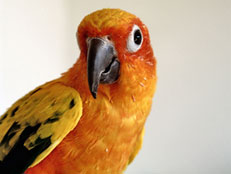
Your cage should at least by 8 inches wide, 22 inches long and 24 inches high. If you get a larger variety, such as a Patagonian, you need one that’s 24 inches wide, 36 inches long, and 30 inches high. Some enthusiasts even recommend getting a cage that’s 44 inches wide, 26 inches long, and 40 inches high. That’s enough space for you to put toys and several branches—conures are very playful birds and need plenty of stimulation so they won’t get depressed or even destructive.
You also need to check the space of the bars. Can the bird get its head caught between them? Conures are curious and they will try to wriggle out of their cage at least once.
Many cages come with perches, but enthusiasts suggest replacing these altogether. The standard perches are just too thin for conures, and this can ruin their grip and cause their toenails to become overgrown. Avoid concrete perches, which can hurt a bird’s feet. Instead, buy a special perch that’s at least 1 inch in diameter, or scavenge for branches in your own backyard. Willow, elder, eucalyptus and even those from small fruit trees are ideal. Just make sure that they haven’t been contaminated with insecticide. To be safe, disinfect them by roasting them in the oven for about 20 minutes at 400 degrees F, or soak them in a chlorine bleach solution.
You’ll need to line the cage with beddings. Avoid newspaper, since the ink can stain the feathers, and buy butcher paper, plain white copy paper, or plain newsprint. The simple paper also makes it easier to spot any change in the color or consistency of the droppings, a sure symptom of disease.
Some people use pine shavings or crushed walnut shells for beddings, but hose are actually dangerous. Birds may try to eat it, leading to digestion problems and even respiratory illness. These organic beddings can also become a hotbed for bacteria, because of their tendency to absorb moisture.
Conures can get very nervous or aggressive if they don’t feel safe in their environment. That’s why it’s best to avoid round cages, which offer no place for them to hide when they hear a loud, sudden noise.
It’s best to get a rectangular or square cage, and then place one side against a wall or corner. .Never put a cage in a kitchen. Cooking fumes can be poisonous to birds, especially the chemical emitted by heated Teflon.